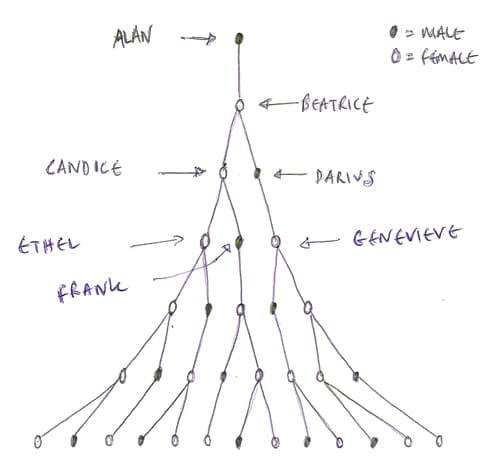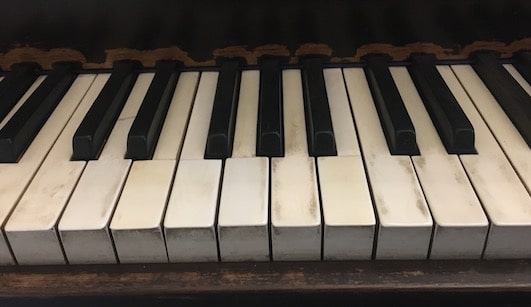
A while ago, I was teaching at the Glamorgan Summer School. Mr. Jack Jones, the trumpet player (and retired maths teacher, and ultra nice guy) in my class, told me this story of the ancestry of a male bee. Sitting comfortably? Then I’ll begin…
Females come from the fertilised eggs.
Males come from the unfertilized eggs.
So, a female bee has a mother and father. And a male bee has only a mother – a mummy’s bee, if you like.
Here’s a little diagram to show you this sequence.

At the top of the diagram is a male bee; let’s call him Alan. Below Alan [the white dot, one generation back] is his mother – call her Beatrice. Beatrice, being female, has a mother and father – Candice and Darius. Continuing the pattern, Candice has a mother and father, and Darius only has a mother. And so on. It’s an idealised generational model, by the way. I suppose they’re a bit more liberal in the hive :)
Now, if all that sounds like gibberish, check out this guy doing a much better job of explaining it all.
Anyhow, apiarists have known this for hundreds of years. Scarlett Johansson and Steve Vai know it. But it was Fibonacci who introduced the idea to the West in his Liber Abaci [not this]. The number of bees in each generation, going backwards, is therefore called – the Fibonacci sequence; i.e., [0] 1, 1, 2, 3, 5, 8, 13, etc. And this has many interesting properties.
Patterns
Here’s one pattern: Look at the last row of 13 black and white dots on my diagram above. It’s the same arrangement as a piano keyboard.

More Fibonacci numbers: there are 13 notes in one octave (C to C), 8 white notes and 5 black notes.
You could go on and try to find the answers to the universe or justify your belief that spiders created the world as we know it or whatever, or you could just use the patterns to mess around with and see what you can come up with.
For example, check out this video of a Tool song to which someone has kindly added an explanation as to how they used the Fibonacci sequence in the song.
https://www.youtube.com/watch?v=WeWGL_MIBtI
Not sure I totally agree with their idea of living your life like a Fibonacci sequence. It might get a bit messy when ordering the next round, for instance. But Fibonachos, that could work…
There are some interesting reads on the Fibonacci sequence here. And check this Bobby McFerrin video out too.
Hi Mike
This is great stuff and the Bobby McFerrin clip is beautiful.
In 1990 I studied at Banff in Canada and Steve Coleman was the artistic director and very influential on me at the time.
He didn’t use any notated music in the whole month in his teaching.
He is interested in all kinds of concepts to inform his music including symmetry and the golden ratio/fibonacci series. He was also into Bartok whose music is very influenced by these proportions and Erno Lendvai has written about this in Bela Bartok: An Analysis of His Music.
At the time I used the idea of the fibonacci series it in a very simple way by composing a tune (Twisted Tungo from my 1st cd In Our Time ) with the opening phrase intervals being in the golden ratio (also called golden mean or section) proportions. This was a great starting point for a composition and these proportions can be used rhythmically and melodically and developed in a much greater way that I did.
I did it by using intervals of a tone, minor third, perfect fourth, minor sixth which equates to 2, 3, 5 and 8.
Since that year I have not used it again!
Vijay Iyer who played with Steve Coleman wrote this article
http://www.guardian.co.uk/music/2009/oct/15/fibonacci-golden-ratio
and check out Steve’s website. Lots of articles. I particularly like this recent one on his rhythmic analysis of Charlie Parker.
http://www.jazz.com/dozens/the-dozens-steve-coleman-on-charlie-parker
Martin
Great stuff, thanks! Nick Kacal told me a great Steve Coleman story about him demonstrating some Parker solos by playing along with them *exactly* and then showing how he devloped things out of Parker’s music for his own music.
I’ve seen those articles about Parker on SC’s site. Interesting stuff. Take it you’ll have read Evan Iverson’s article on KoKo and Line Up? http://thebadplus.typepad.com/dothemath/2008/05/lennie-tristano.html
Also did a Spotify playlist of omnibook here – https://www.mikeoutram.com/2009/11/charlie-parker-omnibook-as-a-spotify-playlist.html
I’ll have to get the book about Bartok too :)
Not sure if I have your 1st CD. With JP?
Thanks for linking the Vijay article. Seb Scotney told me about that too.
I really like how taking a seemingly academic thing like a tone row or fibonacci or whatever can, by taking away the bottomless pit of options, make it easier to focus on something and rinse it to death :)
Am still making my record, I’ll have to play what I’ve got so far to you soon, would love you to hear it. I think I’ve used focusing on a picture/feeling in the same but different way. MY GOD, do I want to finish my album. Need to find a way to just prduce things really quickly. Let’s do a duo record in the New Year, we could do it round mine.
Sorry, I went completly waffly there :) M
Hah! Martin beat me to exactly the same Vijay Iyer article. I came across it when I was reviewing his album Historicity which uses the Fibonacci series in an exciting way.
And Vijay studied with Steve C so that makes sense.
The way Vijay uses it in rhythmic terms works really well. He takes a 4/4 bar broken into a group of 3 1/8 notes followed by 5/8 notes – the basic Charleston figure and develops the ratio fro 3-5 to 5-8 to 8-13. The rhythmic expansion sounds quite organic.
I played with a composer called Martin Glover while in Hull and he wrote Fibonacci influenced music which was also quite influenced by Bartok.
I have a nice little book on Fibonacci in nature, music and architecture somewhere – must re-read it!
Great review, Phil! http://www.notreble.com/buzz/2009/11/10/a-review-of-vijay-iyer-trios-historicity/
Here’s Vijay’s album on Spotify. The Fibonacci related track is Mystic Brew. Yeah, it does sound cool. I haven’t really checked out his music properly yet. Think I’m putting it off because it might give me headaches :)
http://open.spotify.com/album/3I3uK5mo0uvj4TnSCxS2zk
Maybe we share a Glover! Might be the same Martin Glover who was my composition supervisor for my MMus. Unfortunately, I only got one lesson. Would like to hear his music.
Do you know what the book is? I have a recommendation for ‘Godel, Escher, Bach: An Eternal Golden Braid’. might get that soon.
I’ll have to check my books. Martin studied at one of the big London music colleges – can’t remember which one – then taught classical guitar in Hull. He played keyboards including a fabulous old Fender Rhodes. We had a band playing his compositions and those of a great saxophonist Peter Minns, kind of Weather Report meets Bartok meets funk – and we did some electronic serialist stuff.
I saw him about ten years ago as some of his string quartets were premiered in London. Sadly he died a year or two back. Wonder if it was the same guy?
Would love to hear your album and a duo recording is a great idea. I will have a listen to Vijay now although I tried once before with a different cd of his and it wasn’t for me. He is doing some interesting things though.
Hey Mike,
I’ve known about the Fibonacci sequence before, but to see that it is mirrored in the keys of the piano etc is truly fascinating (and an especially good read at 3:24am). Some philosophers might argue that it is potentially evidence of the existence of God or some other divine architect and it really is food for thought. I’m really not mathematically minded at all but this all reminds me of the so called ‘divine ratio’ or “phi” as it’s sometimes known. According to the almighty source of knowledge Wikipedia “The mathematics of the golden ratio and of the Fibonacci sequence are intimately connected”, and I’ve read that Satie, Debussy, Bartok and many other composers have supposedly used the divine ratio in their compositions. It also pops up in art, architecture and in many natural and biological forms too (Leonardo DaVinci’s Virtuvian man springs to mind). I even remember it popping up when I used to work as apprentice to my local luthier in the geometry and ratios of acoustic guitars, cellos, violins etc. Truly fascinating stuff… although it does beg the question, if you go looking for patterns in these things, is it inevitable that you will eventually find them?
Hi Mike,
I’ve recently remembered the name of the book I mentioned above. It was “Geometry, Proportion and the Art of Lutherie” by Kevin Coates. I’d really love a copy of it but last time I checked it was out of print and thus copies are at around £90. Nevermind eh. If I do ever track down a copy then I’ll be sure to let you know.
RR
Yep, let me know if you get a copy. Sounds interesting :)
Hello Mike – this may be related… or not! Lionel Grigson used to love pointing out the proportional relationship between Bembe and the construction of the major scale (TTSTTTS) – both divisions or groupings within twelve (with a crotchet equalling a tone and a quaver a semitone).
He’d then play a recording of African drumming where the Bembe pattern was displaced seven times – effectively giving the rhythmic equivalent of each mode of the major scale in one cycle.
It’s sort of interesting I guess … it was a long time ago!!!!
Fascinating. The following has nothing to do with music, but I learned about the Fibonacci series over 30 years on a Computer Science degree course. It’s one of many naturally occurring phenomena that are recursive; in other words it can be defined in terms of itself.
And reflecting that, a year or two later I wrote a brief computer program to determine the Nth term of the series, which calls itself twice. It returns the sum of fib(n-1) and fib(n-2).
Still have it and would post it here (12 lines) but I suspect the formatting would break.
Cool! I think you can post code in the forum by clicking on the <> symbols. Not sure it would work on these comments. There are quite a few coders in the membership too, maybe you saw Stuart’s name the notes program in the resources section?